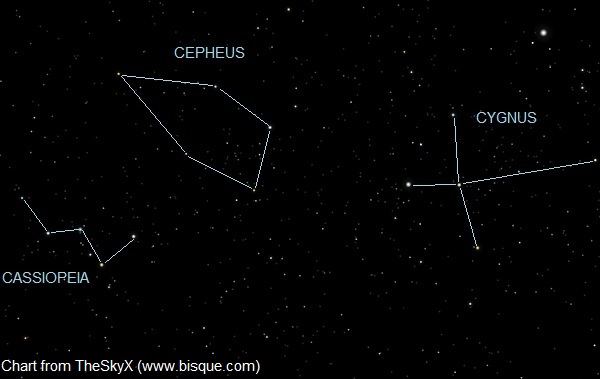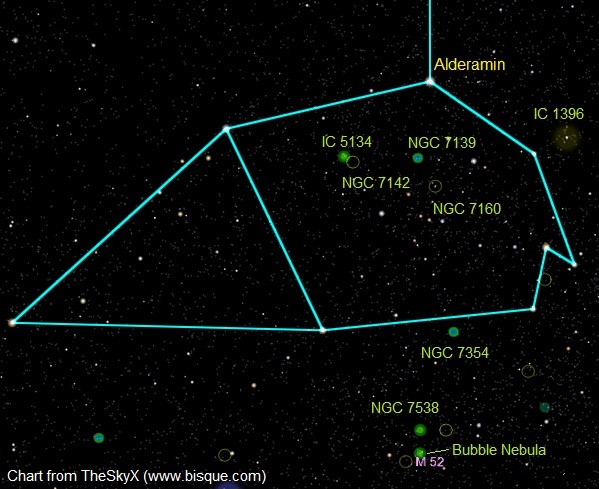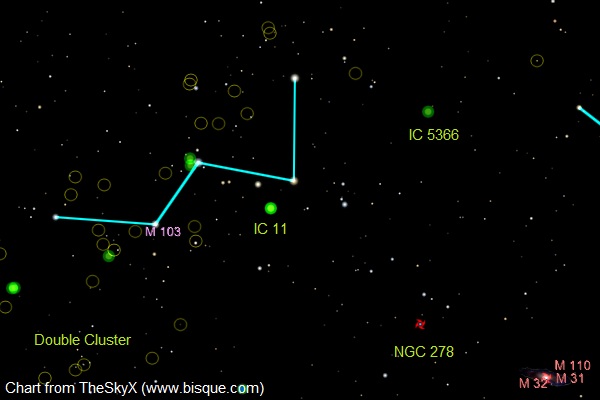Looking Up At Royalty
Perched high in northern skies are two figures of pure royalty. King Cepheus and Queen Cassiopeia were also portrayed as main characters in a famous mythological story. The “Royal Family of Constellations” involves the said King and Queen, as they sacrifice their daughter Andromeda to the sea monster Cetus. But Perseus saves Andromeda in the nick of time and both fly off on the winged horse Pegasus.
With the King and Queen situated high overhead, Dobsonian owners can enjoy the views with ease, as opposed to breaking their backs looking down to the far south such as Sagittarius. Cepheus is not a very prominent formation of stars. The five main suns that make up what appears to be a house or a church range from magnitude 2.4 to 3.7. The easiest way to locate Cepheus is to follow the length of Cygnus the Swan. Start from its head and keep moving north or it can be found above at the top of the Northern Cross.

The alpha star of the constellation is named Alderamin. It is burning hydrogen like our Sun and is located a mere 49 light-years from us – pretty much down the cosmic highway. Alderamin spans about two and a half times wider than our Sun and is about 18 times brighter. Catalogued as an “A” class star, Alpha Cephei spins at 248 km/sec and has a surface temperature of 7,600 Kelvin. With its position being close to the 23.5-degree circle formed by the 25,800 years precession to which our north Polaris is on, Alderamin will be considered our Pole star some 5,500 years from now. Unlike Polaris, Alderamin will be about three degrees off the mark. The North Star is currently sitting at a little more half that value.

About six degrees from Alderamin is IC 1396. At about three degrees in width, IC 1396 is considered one of the largest emission nebulas in our Milky Way Galaxy. It lies some 3,000 light-years from Earth and is being lit from a bright bluish star at is center. This stellar nursery is hundreds of light-years across and even has another object within its cloud structure that is a target for astrophotographers. Dubbed - the elephant trunk nebula, it is a lengthy concentration of gas and dust and is catalogued as IC1396A. With such a wide object, a telephoto lens piggybacked on a telescope should catch photons of this amazing region.
An interesting planetary nebula is NGC 7139. With dimensions half the size of the famous Ring Nebula, NGC 7139 measures only 1.3 arc minutes in width and glows at a faint magnitude 13.2, it could be a challenge in scopes with less than eight inches in aperture. NGC 7139 is estimated to be 4,300 light-years away. Moving about 2.5 degrees to the north, you will find a pretty open cluster. NGC 7142 teams up with the reflection nebula NGC 7129. The nebula is thought to be 3,000 light-years from us whereas the cluster is double that distance.
We now move east from Cepheus to the famous W outlining the queen. A fantastic open cluster just across the border from Cepheus is M52. Coined the salt and pepper cluster, M52 is a splash of about 200 stars. Once you have enjoyed its view, be sure to slide your scope 35 arc minutes southwest of the cluster to see the magnificent Bubble Nebula. The formation of NGC 7635 is the result of very fast stellar winds blowing off the Wolf-Rayet star seen within and causing the surrounding gas to balloon out – hence the bubble. This star could be going through its final stages of life till it erupts in a supernova explosion.
For a change of pace, let us look at a very compact galaxy catalogued as NGC 278. This magnitude 11.5 islands of stars reside some 35 million light-years away and at first glance, comprises of a tightly wound galactic arm that almost takes on the appearance of an elliptical galaxy.

The universe is never a dull place. Events do occur but seem few and far between. With memorable views of supernova, SN 2011dh in the Whirlpool Galaxy discovered back in June buzzing in our heads, there is news of another explosion in another remote galaxy. The galaxy M101 is now displaying a type 1a supernova. It should now be around magnitude 11 and within reach of binoculars.
Of the four comets that were within the range of telescopes, three are close to or in the solar glare and therefore a challenge, to say the least. Comet C/2009 P1Garradd is zipping along with interstellar space and is well placed for all night viewing. In fact, Garradd will only get better till the middle two weeks in February 2012 when it is expected to peak at magnitude 7.0. Use the chart to follow its path against the stars. Another great Kodak moment comes on Sept 3rd when it slides under Collinder 399 aka The Coat Hanger. Garradd is sporting a faint tail that appears on photos.
On the planetary scale – Jupiter is taking center stage. It rises before 11 p.m. local time and at magnitude -2.7 is a beacon in the sky. Mercury is gaining altitude and is at great elongation at 18 degrees on the morning of the 3rd. Five days later on the 8th, be sure to set your clocks early to catch Mercury very close to the star Regulus.
This month’s full Harvest Moon will occur at 5:27 a.m. EDT on the 12th. Eleven days later on the 23rd, the Fall Equinox is listed at 5:05 a.m. EDT. For the next six months, nighttime hours will be longer than daylight hours. And finally, as the sun sets on the 29th, look for Venus low in the west. Once you have spotted it, try to get your last glimpse of Saturn 1.2 degrees above.
Until next month, clear skies everyone.

